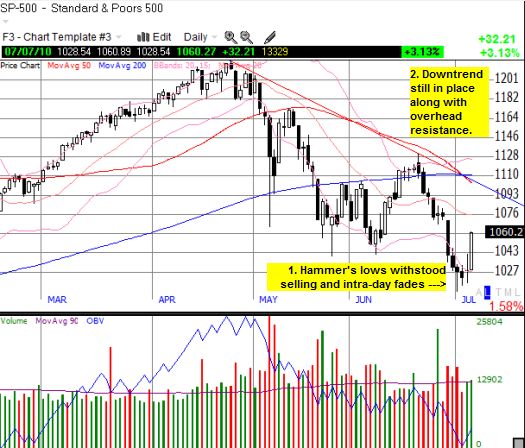It took a little patience, but the bounce from oversold conditions delivered in spectacular fashion on Wednesday with a 3.1% jump. The setup this time was a “bullish hammer” that formed ahead of the U.S. unemployment report last Friday. This is how I described the setup at the time:
“The good news is that the S&P 500 did not break the psychologically important 1000 level. The index even formed a bullish hammer pattern. Combined with oversold conditions, the index is primed for a strong and sharp relief rally (stochastics are oversold, but the percentage of stocks trading above their 40-day moving average (DMA), T2108, is 25%, still above the 20% oversold threshold)….
….For now, I am positioning for a bounce in the S&P 500. I would have preferred to do so with T2108 below 20%, but the hammer and oversold stochastics increase the chance of a bounce. Moreover, there is enough negative sentiment and valuations are cheap enough to encourage contrarians and buyers back into the mix on any signs of hope. Regardless, I expect any bounce to be about as sharp as the previous two…but also just as short-lived.”
(Sure enough, respected money manager Doug Kass has emphatically called for a lasting bottom based on valuation and excessively negative sentiment. His expectation for a 10-11% rise from here to year-end only puts the S&P 500 at the June highs and flat for 2010 – the target sounds very plausible to me given my earlier expectation for a summer trading range).
What I did not recognize at the time, but realize now, is that the 9 days following that disappointing unemployment report unfold into a vacuum of fresh U.S. economic news. Poor economic news helped pressure the market to 9-month lows, so it makes sense that a deeply oversold market could finally find some reason to rally absent new bad news. Similarly, the bias should remain in favor of the bulls with 1040 on the S&P 500 breaking convincingly. However, a downtrend remains in place and strong resistance looms overhead (about 1090-1100). Assuming the market continues to trip and drift upward, the S&P 500 could be colliding with this resistance just as the market gets hit with a fistful of economic releases ahead of options expiration.
(From Wednesday to Friday of next week we get to hear about advance retail sales, Federal Reserve meeting minutes, and inflation readings from the producer and consumer price indices).
While my favorite indicator T2108 never hit the oversold threshold, some interesting bullish divergences developed as the market coiled in preparation for a sharp bounce. Trader Mike noted how T2108 barely budged even as the market continued to sell off last week. Moreover, the VIX actually declined during the selling last Thursday and Friday of last week. VIX expert Bill Luby earlier explained in “VIX Showing Signs of Progressive Desensitization” that investors were essentially getting news fatigue. Shortly after that, we indeed seemed to reach the point of maximum fatigue where it will now take notably worse news to hike the fear levels (in the short-term anyway). Finally, the S&P 500 refused to break the lows punched out by Wednesday’s hammer even as the selling pressure persisted. Bears focused on the intraday fades. Bulls focused on the intact lows.

*Chart created using TeleChart:

As usual, this kind of bounce initiates an unwind of the short-term trades that were triggered by the oversold conditions. The sell-off from the April highs has now generated four oversold conditions. Three produced very good trades. (See prior posts for descriptions of the setups and/or the resolutions). However, if the downtrend continues, these bounces should get trickier and trickier to play while the shorts at resistance levels will get more and more attractive. I still think the best outcome for the summer is some kind of trading range. If the S&P 500 manages to overcome short-term overhead resistance, I will have to re-evaluate all my assumptions.
Be careful out there!
Full disclosure: long SSO, IVV
